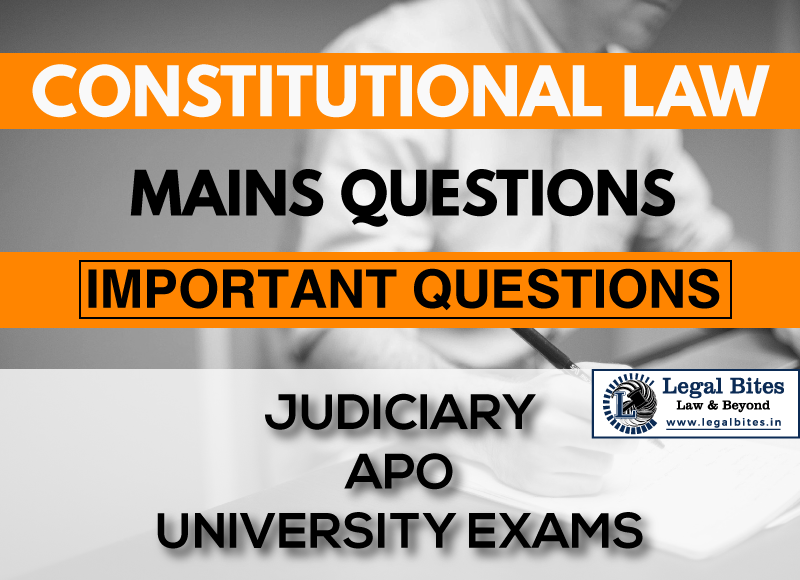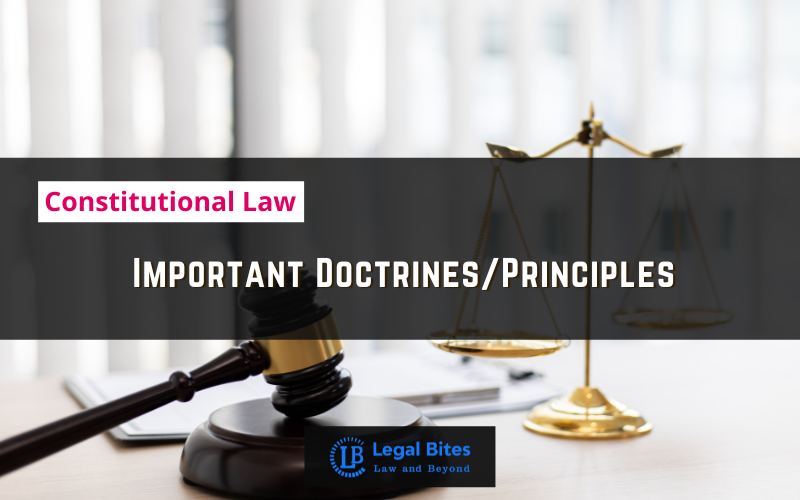What remedies can be enforced under Article 32 of the Constitution of India?
Question: What remedies can be enforced under Article 32 of the Constitution of India? [RJS 1986] Find the answer to the mains question only on Legal Bites. [What remedies can be enforced under Article 32 of the Constitution of India?] Answer Article 32 of the Constitution (Right to Constitutional Remedies): It is a fundamental right, which states that… Read More »
;
Question: What remedies can be enforced under Article 32 of the Constitution of India? [RJS 1986] Find the answer to the mains question only on Legal Bites. [What remedies can be enforced under Article 32 of the Constitution of India?] Answer Article 32 of the Constitution (Right to Constitutional Remedies): It is a fundamental right, which states that individuals have the right to approach the Supreme Court seeking enforcement of other fundamental rights recognized by the Constitution....
Question: What remedies can be enforced under Article 32 of the Constitution of India? [RJS 1986]
Find the answer to the mains question only on Legal Bites. [What remedies can be enforced under Article 32 of the Constitution of India?]
Answer
Article 32 of the Constitution (Right to Constitutional Remedies): It is a fundamental right, which states that individuals have the right to approach the Supreme Court seeking enforcement of other fundamental rights recognized by the Constitution. The Supreme Court has the power to issue directions or orders or writs for the enforcement of any of the fundamental rights. The writs issued may include habeas corpus, mandamus, prohibition, certiorari, and quo-warranto.
Since the right guaranteed by Article 32 to move the Supreme Court in case of infringement of a fundamental right is in itself a fundamental right; therefore, the availability of alternate remedy is no bar to relief under Article 32. However, the SC has ruled that where relief through the high court is available under Article 226, the aggrieved party should first move the high court. In the Chandra Kumar v. Union of India case (1995 AIR 1151), the SC ruled that the writ jurisdiction of both the high court and the Supreme Court constitute a part of the basic structure of the Constitution.
The right to Constitutional Remedies which are available under the Article 32 and 226 of the Constitution for the enforcement of fundamental rights are:
-
Habeus Corpus
The literal meaning of the Latin words ‘Habeas Corpus’ is to ‘have the body. This writ is basically meant for a remedy against the illegal confinement of a person. It is a writ in the nature of an order calling upon the person who has detained another to produce the latter before the Court, in order to let the Court know on what ground he has been confined and to set him free if there is no legal justification for imprisonment.
The only precondition necessary is that the person should have been confined and such confinement should be illegal.
2.Mandamus
Mandamus is a Latin word having the meaning “We command”. The primary purpose of this writ is to make the Government, machinery work properly. An order of mandamus is a command directed to any person, corporation, or an inferior tribunal, requiring them to do some particular thing which pertains to their/his office and which is in the nature of public duty.
3.Prohibition
The object of this writ is to restrain the Courts of inferior tribunals from exercising a jurisdiction which they do not possess at all or to prevent them from exceeding the limits of their jurisdiction. In other words, the object is to confine the Courts or Tribunals of inferior or limited jurisdiction within their bounds.
The writ of prohibition lies not only for the excess of jurisdiction or for the absence of jurisdiction object is to confine the Courts or Tribunals of inferior or limited jurisdiction within their bounds.
4.Certiorari
Certiorari means “to certify”. A writ of certiorari (cert.) is an order of an appeal or appellate court ‘directing a lower court to deliver the record in the case for review. In other words, it is a writ which is issued by the High Court to subordinate judicial or quasi-judicial bodies directing them to transfer the records of a particular case in order to ascertain whether the court has the jurisdiction to give the order or whether it is against the principles of natural justice. A writ of certiorari is corrective in nature.
5.Quo-warranto
This writ is issued by a superior court inquiring by what authority a person claims to exercise a particular right, or to hold a particular office. It is a device to control executive action in the matter of making appointments to public offices. In this process, the usurper of public office may be removed and the rightful person may be allowed to occupy this office.
Public Interest Litigation
Public interest litigation means litigation filed in the court of law with the view to protect the interest of the general public. The high court can hear matters of PIL filed under Article 226. Through PIL persons who were not directly affected in the case may bring to the notice of the court matters of public interest. It is the power granted to the public by the courts.
Important Mains Questions Series for Judiciary, APO & University Exams
- Constitutional Law Mains Questions Series Part-I
- Constitutional Law Mains Questions Series Part-I
- Constitutional Law Mains Questions Series Part-II
- Constitutional Law Mains Questions Series Part-IV
- Constitutional Law Mains Questions Series Part-V
- Constitutional Law Mains Questions Series Part-VI
- Constitutional Law Mains Questions Series Part-VII
- Constitutional Law Mains Questions Series Part-VIII
- Constitutional Law Mains Questions Series Part-IX
- Constitutional Law Mains Questions Series Part-X



